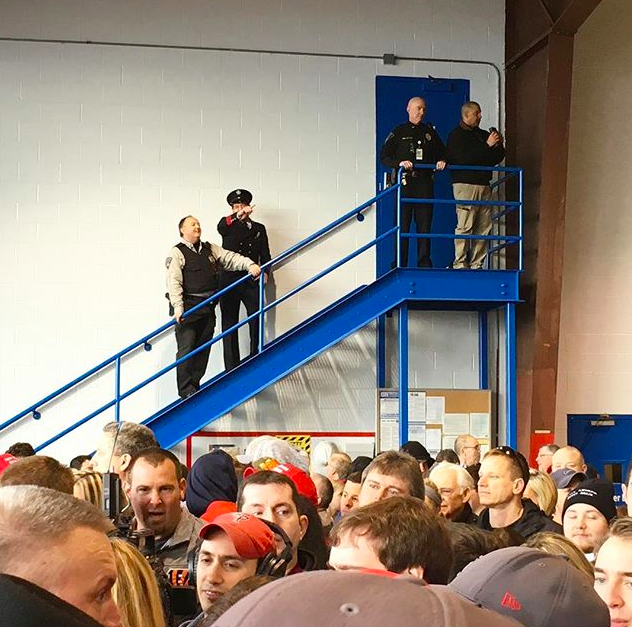aNewDomain  — I think it was over Thanksgiving dinner. My mother’s best friend, a dear woman who has never been other than good to me and my mom, decided to poke some gentle fun, Dayton Ohio-style, at me.
— I think it was over Thanksgiving dinner. My mother’s best friend, a dear woman who has never been other than good to me and my mom, decided to poke some gentle fun, Dayton Ohio-style, at me.
Actually, let me be more specific. It wasn’t Dayton. The conversation took place in Kettering. It’s a suburb of Dayton. A small suburb called Oakwood separates Dayton and Kettering.
“Ted,” my mom’s friend began, “what’s with these terrible descriptions of our city? The way you write, you’d think this was some bleak post-industrial wasteland.” She motioned out the window to her manicured lawn, punctuated by a set of perfect flowers. As were those of her neighbors. As if to drive home her point, a bird chirped.
I held my ground. “What about down by Route 4? Rusted-out factories, meth houses. It’s like a war zone.”
“But that’s” — she searched for the word — “downtown. That’s not here.”
“It’s five or six miles, at most,” I pointed out. “You can walk there!”
And you can, if you don’t much care about personal safety.
Dayton is a mess. Once a booming manufacturing city, its population is plunging, having shrunk by half in 50 years. Its housing stock, including historical buildings, have been gutted. After decades of factory and corporate closures accelerated by free trade deals like NAFTA, the local economy sucks.
READ: The Gutting of Dayton: Why My City Is Gone
Crime, driven by my hometown’s status as Ground Zero of the national opiod epidemic that has turned so many young men into corpses that the morgue ran out of room, has made Dayton even more dangerous than Chicago.
The 2008-09 housing crisis left countless homes abandoned (but cheap! you can buy one for four figures).
 Fearing eviction in 2009 but receiving no help from a government who instead gave $7.77 trillion to the banks with no strings attached, one poor guy hanged himself; a kid found his mummified body five years later. He should have stuck around.
Fearing eviction in 2009 but receiving no help from a government who instead gave $7.77 trillion to the banks with no strings attached, one poor guy hanged himself; a kid found his mummified body five years later. He should have stuck around.
The banksters never bothered to foreclose on his modest house.
So much misery, so little help from the government. Four out of five Ohioans who lost their jobs receive zero unemployment benefits.
Downtown Dayton, and its citizens, were dead to my mom’s friend. But not to me. I used to take the bus there to look at record stores and attend meetings at Democratic Headquarters.
Sometimes, yes, I walked. After I left Dayton for New York, the road from the Dayton airport to my mom’s house sometimes took me through downtown. Downtown was real. Downtown existed.
If downtown Dayton was less than afterthought to suburbanites a hop, skip and jump away, it was a black hole as far as the national media and the political strategists were concerned. Daytonians didn’t donate to presidential campaigns. (They couldn’t afford to.) More than 40% black as the result of postwar “white flight” to suburbs like Kettering and Oakwood, downtown was reliably Democratic. Republicans didn’t bother; Democrats took Dayton for granted.
You’ve probably already figured out that this essay is a parable about the Rise of Trump.
Downtown Dayton is far from unique. There were downtown Daytons all over the post-industrial Midwest: ignored, forgotten, taken for granted. Ohio, Pennsylvania, Wisconsin — states Hillary Clinton ought to have won, and was so sure she was going to win that she hardly showed up, but went Republican in 2016.
Dayton Congressman Tony Hall (disclosure: I worked for one of his campaigns) watched the growing chasm between his working-class — and unemployed poor — constituents and the national Democratic Party, in thrall to the Clintons, free trade, and Wall Street contributors. “A lot of Democrats in the Midwest feel that they didn’t leave the Democratic Party — they feel like the Democratic Party left them,” Hall says. That was me, for sure. “As long as we had our 10 or 12 auto plants, we were pretty good, but we felt that the NAFTA deal made it a lot easier for companies to go to Mexico — and they did. They shut down our factories,” remembers Hall.
Young adult voters “saw their moms and dads lose their jobs and they didn’t think anyone did anything for them.”
Day after day, the citizens of Dayton and Flint and Milwaukee opened their newspapers and flipped the cable news channels. Never, ever was there anyone talking about, much less interested in solving, their problems. As far as the elites — and that included Democratic politicians like Hillary — were considered, victims of rapacious global capitalism didn’t exist and didn’t matter.
Until Trump.
Trump didn’t offer credible solutions. He hasn’t lifted a finger to help Rust Belters as president. What he did do was acknowledge their existence.
Writing about the French election, Édouard Louis wrote that a similar cri de Coeur motivated many Marine Le Pen voters. Louis grew up poor: “In the minds of the bourgeoisie…our existence didn’t count and wasn’t real.” That was the message of many Trump voters to the op-ed writers of The New York Times: we know he isn’t perfect, but at least he knows we exist.
Despite Bernie (and Trump), the Hillary Clinton Democrats still don’t get it. When Trump mentioned “mothers and children trapped in poverty in our inner cities, rusted out factories scattered like tombstones across the landscape of our nation” in his inaugural address, my liberal New York friends shook their heads.
Like my mom’s friend, they had no idea what Trump was talking about.
The misery is real.
They exist — sometimes they exist five or six miles away.
They are us.
For aNewDomain, I’m Ted Rall.
Cover image: DaytonDailyNews.com, All Rights Reserved; Inside image: Storify.com in Dayton, All Rights Reserved.













